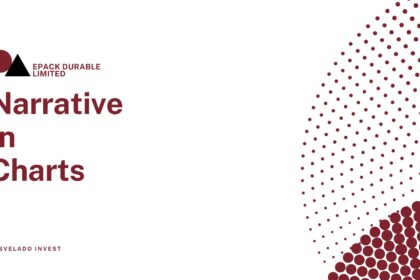India is the world’s second-largest producer of textiles and garments and holds the fifth spot in textile exports, covering apparel, home, and technical products. With a 4.6% share of the global textile and apparel trade, the industry contributes to India’s economy, representing 2.3% of the GDP, 13% of industrial production and 10.5% of exports.
The global apparel market is projected to grow at a CAGR of 8%, reaching US$ 2.37 trillion by 2030, while the global textile and apparel trade is expected to grow at 4%, reaching US$ 1.2 trillion by the same year. India’s domestic textile and apparel market is forecast to grow at a CAGR of 10%, hitting US$ 350 billion by 2030, with exports estimated to reach US$ 100 billion.
India remains the largest producer of cotton globally, with the Agriculture Ministry projecting cotton output for 2023-24 at 32.3 million bales. In FY24, the value of Indian cotton yarn exports reached US$ 3.7 billion, while overall textile exports stood at US$ 9.17 billion during April to June FY25. The Cotton Association of India (CAI) estimates the total cotton availability in 2023-24 at 34.6 million bales, against a domestic demand of 31.1 million bales.
The Indian government increased its budget allocation for the textile industry in 2024-25 to ₹4,417 crore (approximately $530 million), reflecting a strong push to boost this vital sector. This increase is up from ₹3,443 crore in the previous fiscal year, signaling further industry expansion.
On the other hand, the winter wear market in India has seen the emergence of a wide variety of materials, designs, and styles over the last few decades to accommodate the shifting lifestyles and preferences of modern customers. Thus, like other areas of the fashion business, casual, lightweight clothing is becoming more popular for winter use. The increased popularity of knitwear is primarily due to this trend towards informal looks and comfort wearing.
Exhibit 1: India’s Textile and Apparel Industry Set for 13% Growth, Reaching USD 250 Billion by FY30
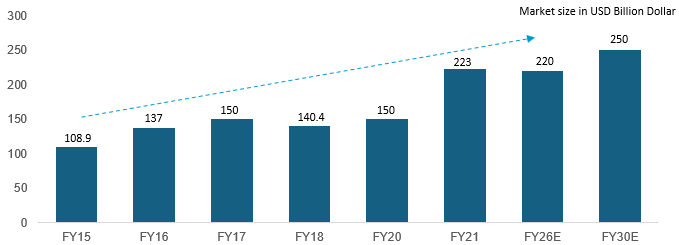
Source: Statista
Key Segments of Textile Industry
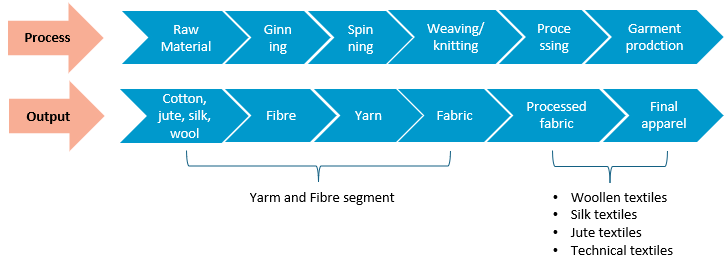
Raw Cotton and MMF Production Increasing
• India is the world’s largest producer of cotton. Estimated production stood at 320 lakh bales during cotton season 2023-24.
• Cotton and fibres are the two major segments in this category. Production of man-made fibre has also been stagnant.
• In FY19, the production of fibre in India stood at 3601 thousand tonnes, which declined 2899 thousand tonnes in FY24.
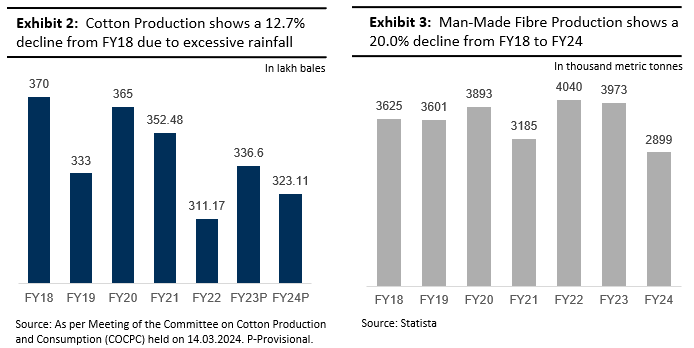
Home Textiles
India’s home textile industry expanded at a CAGR of 9.8% during 2024-29 and reached $9.6 billion in 2024 from $4.7 billion in 2014. The growth in home textiles is driven by growing household income, increasing population, and growth of end-use sectors like housing, hospitality, healthcare, etc.
Exhibit 4: India’s Home Textile Market is expected to grow from USD 9.60 Billion in 2024 to USD 15.36 Billion by 2029 with a CAGR of 9.84%
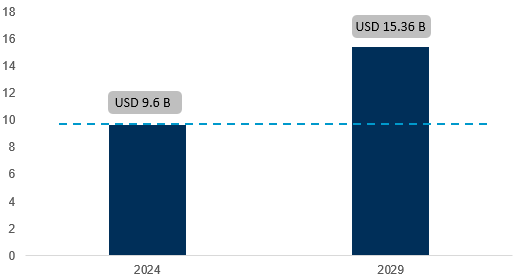
Source: Mordor Intelligence
Policy Support
• 100% FDI (automatic route) is allowed in the Indian textile sector.
• Under Union Budget 2023-24, the total allocation for the textile sector was Rs. 4,389.24 crore (US$ 536.4 million). Out of this, Rs. 900 crore (US$ 109.99 million) is for Amended Technology Upgradation Fund Scheme (ATUFS), Rs. 450 crore (US$ 54.99 million) for National Technical Textiles Mission, and Rs. 60 crore (US$ 7.33 million) for Integrated Processing Development Scheme.
• The Government’s Rs. 10,683 crore (US$ 1.44 billion) PLI scheme is expected to be a major booster for the textile manufacturers. The scheme proposes to incentivize MMF (man-made fiber) apparel, MMF fabrics, and 10 segments of technical textiles products.
• The Government approved the Mega Integrated Textile Region and Apparel (MITRA) Park scheme worth Rs. 4,445 crore (US$ 594.26 million) to establish seven integrated mega textile parks with state-of-the-art infrastructure, common utilities, and R&D lab over a three-year period, which will boost textile manufacturing in the country.
• The Indian government wants to establish 75 textile hubs, similar to Tiruppur, which will greatly increase employment opportunities while promoting the export of textile products and ensuring the use of sustainable technology.





